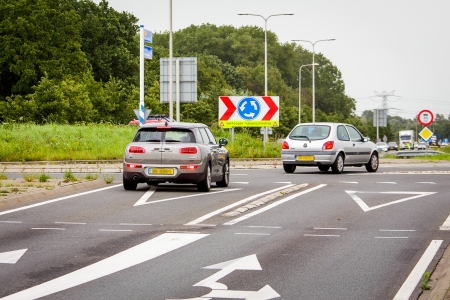Roundabouts are the safest intersection type because of the following three characteristics:
- They have fewer points of conflict (see Figure 1);
- Speed is reduced, especially when the legs have perpendicular connections to the roundabout;
- The impact angle is smaller.
In terms of road safety, roundabouts should therefore be preferred to other types of intersection. First, single-lane, four-legged roundabouts only have 4 conflict points, compared to the 24 conflict points of ordinary four-legged intersections [9]. This difference is easy to spot when looking at Figure 1 below. The median island ensures fewer conflicts, since motorised traffic can only flow in one direction. This makes a roundabout less complex than other types of intersection.
 Figure 1. The differences in conflict points between roundabouts, three-legged and four-legged intersections.
Figure 1. The differences in conflict points between roundabouts, three-legged and four-legged intersections.
Second, because of the layout and priority regulation of roundabouts, all traffic flows need to reduce speed, whereas this is not the case at many other types of intersection [20]. The median island ensures that road users cannot cross in a straight line. Together with the perpendicular location of the legs, this has a speed reducing effect. There are roundabouts with deflecting legs or multiple lanes; they have a lesser speed reducing effect. The priority regulation reduces speed since road users intending to enter the roundabout have to give right of way to traffic already on the roundabout. Third, the layout of a roundabout makes for an entry angle that is smaller than that of other intersection types, which also diminishes the impact angle. Certain conflict types therefore no longer occur on roundabouts [21]. On a roundabout, there are more lateral conflicts which are relatively less serious, whereas at other intersection types, frontal conflicts, that are often relatively serious, may also occur.
